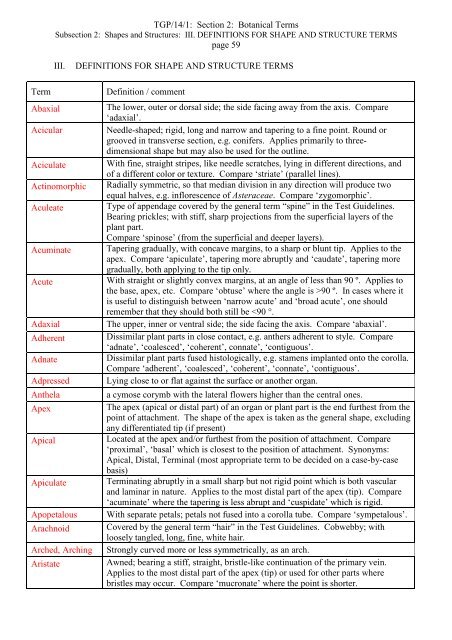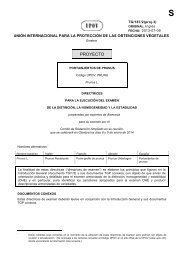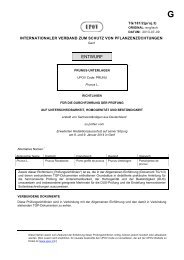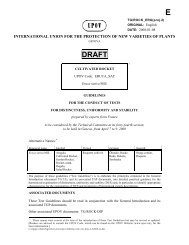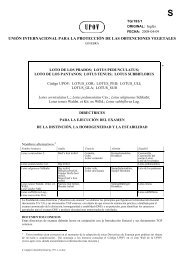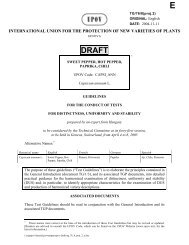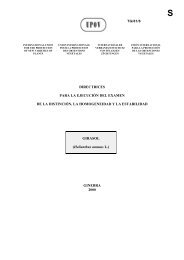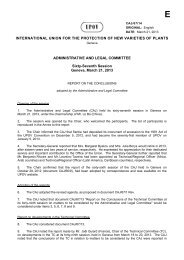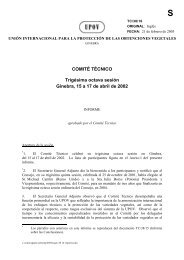E - International Union for the Protection of New Varieties of Plants
E - International Union for the Protection of New Varieties of Plants
E - International Union for the Protection of New Varieties of Plants
You also want an ePaper? Increase the reach of your titles
YUMPU automatically turns print PDFs into web optimized ePapers that Google loves.
TGP/14/1: Section 2: Botanical Terms<br />
Subsection 2: Shapes and Structures: III. DEFINITIONS FOR SHAPE AND STRUCTURE TERMS<br />
page 59<br />
III.<br />
DEFINITIONS FOR SHAPE AND STRUCTURE TERMS<br />
Term<br />
Abaxial<br />
Acicular<br />
Aciculate<br />
Actinomorphic<br />
Aculeate<br />
Acuminate<br />
Acute<br />
Adaxial<br />
Adherent<br />
Adnate<br />
Adpressed<br />
An<strong>the</strong>la<br />
Apex<br />
Apical<br />
Apiculate<br />
Apopetalous<br />
Arachnoid<br />
Arched, Arching<br />
Aristate<br />
Definition / comment<br />
The lower, outer or dorsal side; <strong>the</strong> side facing away from <strong>the</strong> axis. Compare<br />
‘adaxial’.<br />
Needle-shaped; rigid, long and narrow and tapering to a fine point. Round or<br />
grooved in transverse section, e.g. conifers. Applies primarily to threedimensional<br />
shape but may also be used <strong>for</strong> <strong>the</strong> outline.<br />
With fine, straight stripes, like needle scratches, lying in different directions, and<br />
<strong>of</strong> a different color or texture. Compare ‘striate’ (parallel lines).<br />
Radially symmetric, so that median division in any direction will produce two<br />
equal halves, e.g. inflorescence <strong>of</strong> Asteraceae. Compare ‘zygomorphic’.<br />
Type <strong>of</strong> appendage covered by <strong>the</strong> general term “spine” in <strong>the</strong> Test Guidelines.<br />
Bearing prickles; with stiff, sharp projections from <strong>the</strong> superficial layers <strong>of</strong> <strong>the</strong><br />
plant part.<br />
Compare ‘spinose’ (from <strong>the</strong> superficial and deeper layers).<br />
Tapering gradually, with concave margins, to a sharp or blunt tip. Applies to <strong>the</strong><br />
apex. Compare ‘apiculate’, tapering more abruptly and ‘caudate’, tapering more<br />
gradually, both applying to <strong>the</strong> tip only.<br />
With straight or slightly convex margins, at an angle <strong>of</strong> less than 90 º. Applies to<br />
<strong>the</strong> base, apex, etc. Compare ‘obtuse’ where <strong>the</strong> angle is >90 º. In cases where it<br />
is useful to distinguish between ‘narrow acute’ and ‘broad acute’, one should<br />
remember that <strong>the</strong>y should both still be


